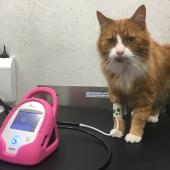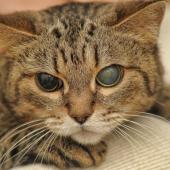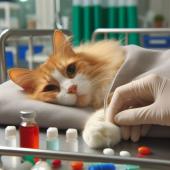Living with a Blind Cat: A Guide to Providing Love, Care, and Support

Blindness - living with a blind cat
Just like people cats normally use their vision for getting around, as well as hunting and interaction with other cats. However, a cat with poor vision or even total blindness can lead a comfortable and fulfilled life.
Blindness in cats can result from various causes, including age-related degeneration, genetic conditions, injury, or illness. Regardless of the cause, adapting to their new reality is essential for both the cat and the owner.
How can I tell if my cat cannot see well?
Few signs of blind cat :
- Cloudy eyes
- Uneven or very wide pupils
- Disorientation and bumping into things, especially in low light
- Walking slowly/cautiously with their legs wider apart than usual. Some cats will stay close to a wall to guide them
- Reluctance to jump
- Hiding away and becoming nervous
- Reluctance to go out at night
- Changes in their behaviour
If a cat loses its sight slowly, behaviour changes are harder to detect because the cat is able to adapt to the disability, learning where furniture and other obstacles in the home are. Sudden blindness is much easier to spot. If your cat is bumping into objects it is obvious that they cannot see normally, but actually this may only happen when furniture is moved, or when doors which are normally opened are closed. This is because cats are able to remember the normal layout of their familiar environment, only getting caught out when it is changed.
If your cat is losing its sight you may notice that it is more hesitant and that is reluctant to jump down from a height. Your cat may even climb down by gingerly reaching the feet down first. Most cats are usually happier climbing up onto objects. Cats with reduced sight may walk in a crouched position with their body closer to the ground and stretch their necks out further, using their long whiskers to feel their way. In some cats with vision problems, you may notice a change in the appearance of their eyes, which are discussed in the section below.
Sudden blindness is usually obvious, whereas gradual sight loss can be surprisingly tricky to spot (because most cats adapt to it well). Signs often include:

Why do my cat's eyes look different?
You may notice changes to your cat's eyes with or without apparent changes in their vision. A milky or cloudy appearance to the eyes can be caused by cataracts, (which is when the lens in the eye becomes white instead of clear). Cloudy eyes can also caused by glaucoma, a raised pressure inside the eye, or uveitis which is the medical name for inflammation inside the eye.
Eyes may be red due to high blood pressure causing bleeding inside the eye, or due to glaucoma, uveitisor a growth in the eye. Some conditions affected the retina at the back of the eye - if this is damaged the glow from the back of the eye appears more intense. Retinal detachment may be caused by high blood pressure. In a blind cat the pupils are usually very large and do not contract down to the normal slits in bright light.
If you have noticed a recent colour change in one or both of your cat's eyes, you should take your cat to your vet to have an eye examination. In many cases, your vet will be able to tell you what is wrong and can therefore advise on the best treatment. In some circumstances, your vet may recommend that you are referred to a specialist veterinary ophthalmologist.
The ophthalmologist is better equipped to be able to diagnose certain conditions, and will be able to offer treatment advice and specialised procedures. Some conditions will be managed with eye drops or oral medications, and all conditions are more successfully treated when diagnosed early on in the course of the disease.
How can I test my cat's vision?
As your cat won't cooperate with reading a chart, testing vision in cats can be tricky, even for your vet! There are several tests which a vet will perform, some of which you can try at home.
- Gently wave a hand towards the eye - this would cause a normal cat to blink. It is important not to create an air current when waving a hand, as even a blind cat will sense this and blink their eye as a reflex.
- Shine a bright focused light suddenly into the eye. A normal cat will be dazzled and blink, squint or turn their head away. A blind cat usually continues to stare ahead.
- Play a laser light is rapidly over the floor or wall in front of your cat, or drop cotton wool balls from a height beside the cat. A normal cat can't resist watching the movement.
- Closely observe your cats behaviour, as mentioned earlier.
How can I care for my blind cat?
Cats with visual impairment function very well in familiar surroundings, and it is important to keep the lay-out of the home consistent. With sudden blindness, it is best to initially confine your cat to one room, with food, water and a litter tray available (but all separated from each other). As your cat adapts to one room it can gradually be allowed to explore more and more of the house. Keep the litter tray, food, water and bed in the same place, and if your cat gets disorientated, place them in a familiar place such as in their bed so that they can realise where they are and start again.
A clean litter box should always be provided, even if you allow your cat outside. This provides them an opportunity to relieve themselves inside in a safe place should they feel anxious about venturing outside. It also is a useful point of reference as they will be able to smell it from quite a distance away. The garden can be enclosed to make your cat safe.
Creating a Safe Environment
By obstructing possible risks like fireplaces, window ledges, and balconies, one can increase safety in the home. Make sure you keep the doors to the outside closed. Certain blind cats can be particularly adventurous, so make sure the windows are securely fastened. Leaving toilet seats down might be the best option.
-
Consistency is Key: Try to maintain a consistent environment to help your blind cat navigate. Avoid rearranging furniture and keep their essentials like food, water, and litter box in the same locations.
-
Safety Measures: Remove potential hazards such as sharp objects, small items they could swallow, and secure electrical cords to prevent accidents.
-
Use of Scents: Utilize scents to help your cat identify different areas. You can use scented oils or herbs to mark specific locations, making it easier for your cat to recognize different spaces.
Facilitating Daily Activities
Some cats who were once secure with jumping up onto objects are now blind. You can think about adding a ramp or a low stool or chair to make your cat's favorite spot—like a tall sofa or bed—easier to climb. Cats do enjoy sleeping at high areas. Though your cat might still help himself to the couch or your comfortable bed, think about offering a seat or shelf where they can feel elevated! Scratching posts are still useful for some blind cats, therefore at least one should be available. Cat gyms are useful because they offer a place to play, rest, elevate, and serve as a scratching post.
-
Encouraging Exploration: Encourage your blind cat to explore by using toys that make noise, such as bells or crinkly toys. Supervise their exploration initially until they become familiar with the surroundings.
-
Verbal Cues: Use verbal cues and gentle touches to guide your cat. Speak softly to let them know you are nearby and reassure them when they seem unsure.
-
Creating a Safe Haven: Provide a designated safe space where your cat can retreat to when they feel overwhelmed. This area should have their bed, toys, and water to make them feel secure.
Medical Care and Support
-
Regular Veterinary Check-ups: Schedule regular veterinary visits to monitor your cat's overall health, as blindness can sometimes be a symptom of an underlying medical condition.
-
Grooming: Assist your cat with grooming, especially if they have difficulty reaching certain areas. Regular brushing helps maintain their coat and strengthens your bond.
-
Diet and Exercise: Ensure your cat has a balanced diet and engage them in gentle play and exercise to keep them mentally and physically stimulated.
Emotional Support and Bonding
It is crucial to engage in social interaction with your cat by playing or petting them. Cats can follow toys with bells or rattles, so they're beneficial. Some cats also enjoy mice that squeak on elastic or mice that have been injected with catnip.
-
Patience and Understanding: Be patient and understanding. Cats are remarkably adaptable, and with time, they can learn to navigate their surroundings effectively.
-
Positive Reinforcement: Use positive reinforcement in the form of treats, affection, and encouragement to reward your cat's bravery and progress.
-
Social Interaction: Spend quality time with your blind cat, engaging in interactive play and providing cuddles to strengthen your bond.
Blind cats can have a very happy and fulfilled life, with a little help from their owners. Your vet will provide the best advice about health matters and nutrition. Other advice and support is available - often from owners of other blind cats.
Conclusion
Living with a blind cat requires patience, understanding, and a few adjustments to their environment. With your love and support, your feline companion can continue to lead a happy and fulfilling life. By creating a safe and consistent environment, facilitating their daily activities, providing necessary medical care, and offering emotional support, you can help your blind cat navigate the world with confidence and grace. Embrace the unique journey of caring for a blind cat, and you'll find that the love and companionship they offer are truly exceptional.
The main cat rescue organisation is Blind Cat Rescue - www.blindcatrescue.com .






